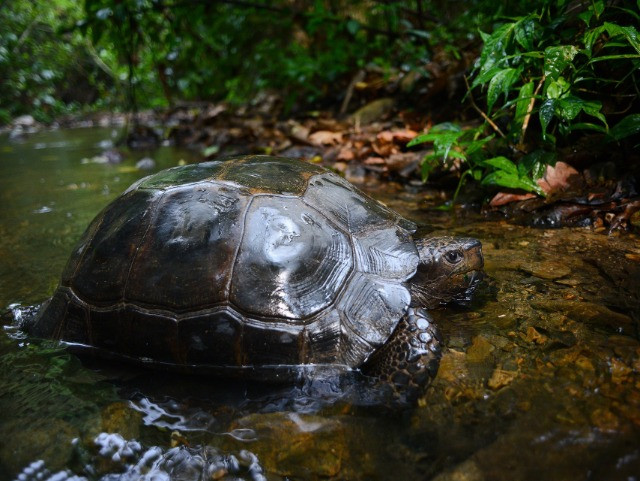Conservation Optimism is a global community dedicated to sharing optimistic stories about conservation and to making people feel empowered to act for nature.
After 30 years of absence, the Asian Giant Tortoise has found its way home again in the Matamuhuri valley, Chattogram Hill Tracts of Bangladesh. Last December ten captive-bred Manouria emys phayrei were released into the forest by a group of conservationists and villagers. This reintroduction is a first for the country and marks a milestone for the conservation efforts of this critically endangered species. Through knowledge, determination, and cooperation these gentle giants have found their way back into the forests of Bangladesh.
The Asian Giant Tortoise is the largest tortoise species in Asia weighing up to 35 kilograms and is considered to be one of the oldest tortoise lineages in the world. While the species plays an important ecological role as a seed disperser, it is currently considered critically endangered as they are threatened by the destruction of primary forest habitat, and subsistence and commercial hunting. The species was thought to be extinct in the Chattogram Hill Tracts until 2011 when researchers found a shell deep in the rainforest.
The road to freedom
This challenging task of saving and protecting the Asian Giant Tortoise in Bangladesh was started with a few conservationists from the Creative Conservation Alliance (CCA) and the Turtle Survival Alliance (TSA). The Creative Conservation Alliance is an NGO dedicated to ecological and cultural conservation of the last wild places in Bangladesh. CCA initiated groundbreaking conservation work over a decade ago in the Chattogram Hill Tracts, bordering India and Myanmar. This region falls within the westernmost edge of the Indo-Burma Biodiversity Hotspot and harbors over 32 globally threatened species. By using a comprehensive approach and grassroots efforts, the CCA empowers local people to become stakeholders in their own landscapes. The CCA is an implementing partner of the Turtle Survival Alliance, a global partnership committed to the conservation of turtles worldwide. Partnering with Bangladesh Forest Department, CCA and TSA have achieved significant milestones on the road to the recovery of several globally threatened species in Bangladesh.
With an aim to reintroduce the Asian Giant Tortoise in the forests of Bangladesh, CCA and TSA partnered with the Bangladesh Forest Department and founded the Turtle Conservation Centre in Bhawal National Park in 2017 and initiated a conservation breeding program. Efforts to breed the Asian Giant Tortoise had already been made years before by other organisations, unfortunately without success. However, this multi-organisational effort finally paved the way to success. In 2018, three hatchlings of Asian Giant Tortoises were successfully reared in captivity in Bangladesh for the first time. The breeding program grew and developed further from then on, with the goal to release these captive-bred Asian Giant Tortoises in the wild someday.
This goal was recently realised, when in December 2021, ten juvenile Asian Giant Tortoises were released in the Chattogram Hill Tracts of Bangladesh by members of the CCA, the Bangladesh Forest Department, and the local community. The released tortoises were hatched in 2019 at the CCA Turtle Conservation Centre, and are the offspring of parents seized from or surrendered by individuals who hunted the animals from the wild for food. Before their release, the tortoises underwent health assessments and disease screenings, and have been fitted with a transmitter. Reformed hunters trained as parabiologists (field technicians) from local communities will monitor the released individuals under the supervision of the CCA.
Community collaborations
These ten young Asian Giant Tortoises now roam free in a 200-hectare community-managed forest located in the Matamuhuri Reserve Forest, Bandarban Hill District. The village chief had provided permission to release the tortoises in the area and a Village Conservation Committee was formed in the village to ensure the protection of the tortoises and their natural home. This five-member committee will act as the local governance system to protect the tortoises and their habitat in specific areas.
The release and monitoring of these ten tortoises will serve as a model for reintroducing other turtle and tortoise species to community-managed forests in Bangladesh and help validate the efficacy of conservation breeding as a tool in restoring wild chelonians. We hope that these ten tiny tortoises would not only help in recovering their own species but would also present a successful and replicable rewilding approach for other species as well.
This story was originally published on 1 February, 2022, on Conservation Optimism.







